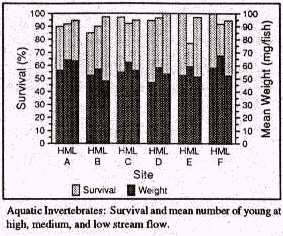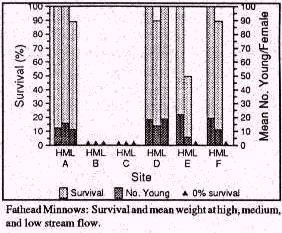Wyoming Water Resources Center

|
RESEARCH BRIEFS Wyoming Water Resources Center |

|
| RB93-104 |
Investigators: Ann M. Boelter, Fred N. Lamming, Aida M. Farag, and Harold L. Bergman
Purpose:
During oil and gas production, the mix of petroleum and water that is trapped
in the petroleum-bearing rocks is pumped to the surface. Co-produced waters
are then separated from the oil and either injected into a well or released
to surface waters. These waters may be high in total dissolved solids,
petroleum contaminants, sulfide, trace metals, and other elements and may be
 toxic to fresh water life in lakes and streams. Petroleum production
operations release large quantities of produced water to Salt Creek in
Northeastern Wyoming, which derives almost all of its continuous flow from
these discharges and contributes a significant portion of the flow in the
Powder River. Specific objectives were to: a) estimate the toxicity of
Salt Creek waters and the persistence of this toxicity downstream in the
Powder River, and b) determine whether any observed toxicity could be
attributed to oil field discharges.
toxic to fresh water life in lakes and streams. Petroleum production
operations release large quantities of produced water to Salt Creek in
Northeastern Wyoming, which derives almost all of its continuous flow from
these discharges and contributes a significant portion of the flow in the
Powder River. Specific objectives were to: a) estimate the toxicity of
Salt Creek waters and the persistence of this toxicity downstream in the
Powder River, and b) determine whether any observed toxicity could be
attributed to oil field discharges.
Methods: Six sample sites were selected: A, B, and C on Salt Creek and D, E, and F on the Powder River. The upstream site A served as a control. All the oil wells releasing discharges that reach Salt Creek are located between A-site and B-site. Water samples were collected from each site three times in the first year (1988) during high, medium, and low flow regimes. Sediment samples were collected in 1990 for pore water and sediment extracts that were preserved for subsequent toxicity tests and analysis for routine chemical parameters. The toxicity of the sample collected in September 1989 at the B-site was characterized by using the toxicity identification evaluation (TIE) procedures developed by the U.S. Environmental Protection Agency (EPA). A second TIE characterization of the B-site water found that it was still toxic after being refrigerated for five months. Using standard protocols developed by the EPA to test instream toxicity, 7-day survival and growth tests with fathead minnows and 7-day survival and reproduction tests with aquatic invertebrates (water fleas) were conducted. After 7 days, the researchers calculated the average dry weight per minnow and the number of young per female of the invertebrates.
Results:
In the first year, Salt Creek contributed 16% of the water in the Powder
River during high flow, 67% during medium flow, and 89% during low flow.
There was insufficient data to figure the Salt Creek flow contributions to
the Powder River during the second year. Due to the nature of the surrounding
soils and bedrock, these waters have naturally high hardness and conductivity.
 However, conductivity, alkalinity, and pH increased within the area of
oil-field discharges (B-site) and then decreased after Salt Creek entered
the Powder River. Hardness decreased with the addition of co-produced
waters. There were no significant effects on fathead minnow survival in
any of the water samples collected from Salt Creek or the Powder River.
However, no water fleas survived in water samples collected during all
three flow regimes in the first year. Fathead minnow weights at all
sites were lower than weights at the A-site during low flow; whereas, no
effects on the number of young invertebrates were seen in the Powder
River sites during high flow. (see graphs).
However, conductivity, alkalinity, and pH increased within the area of
oil-field discharges (B-site) and then decreased after Salt Creek entered
the Powder River. Hardness decreased with the addition of co-produced
waters. There were no significant effects on fathead minnow survival in
any of the water samples collected from Salt Creek or the Powder River.
However, no water fleas survived in water samples collected during all
three flow regimes in the first year. Fathead minnow weights at all
sites were lower than weights at the A-site during low flow; whereas, no
effects on the number of young invertebrates were seen in the Powder
River sites during high flow. (see graphs).
Discussion: The Salt Creek oil field has been a suspected source of pollution to surface waters since as early as 1968. This study showed the detrimental effects of exposure to surface waters at the B-site as well as at sites farther downstream in the Powder River with toxicity tests on water fleas. When Salt Creek comprised about 89% of the Powder River flow, the researchers observed toxicity at F-site, 68 km downstream from the confluence of Salt Creek and the Powder River. Toxicity increased as stream flow decreased. At low flow, no water fleas survived in stream waters below the B-site.
 This study also illustrates the importance of using more than one test
organism whenever possible since water fleas were more sensitive than
fathead minnows at the test waters. This study found significant
correlations between toxicity and individual parameters, especially
sodium, potassium, chlorine, and alkalinity. However, singling out any
one parameter would be misleading due to co-variance among the variables.
The TIE study indicated that non-polar organics, cationic metals, and
sulfide did not contribute to the observed toxicity. A reconstituted
salt solution with an ionic composition approximating that of the toxic
B-site sample was tested. The toxicity of the reconstituted water was very
similar to the toxic B-site sample. Therefore, it is assumed that major
ions accounted for the toxicity of these stream waters.
This study also illustrates the importance of using more than one test
organism whenever possible since water fleas were more sensitive than
fathead minnows at the test waters. This study found significant
correlations between toxicity and individual parameters, especially
sodium, potassium, chlorine, and alkalinity. However, singling out any
one parameter would be misleading due to co-variance among the variables.
The TIE study indicated that non-polar organics, cationic metals, and
sulfide did not contribute to the observed toxicity. A reconstituted
salt solution with an ionic composition approximating that of the toxic
B-site sample was tested. The toxicity of the reconstituted water was very
similar to the toxic B-site sample. Therefore, it is assumed that major
ions accounted for the toxicity of these stream waters.
Implications for Further Study: Salt Creek is very saline; the toxicity of its water could not be attributed to the oil-field discharge. Future studies need to be performed at other locations in Wyoming; that is other water systems that may not be inherently saline or accustomed to large amounts of total dissolved solids may yield different results than those found at Salt Creek.
Publications:
Boelter, A.M., F.N. Lamming, A.M. Farag, and H.L. Bergman. 1992. "Environmental Effects of Saline Oil-Field Discharges on Surface Waters." Environmental Toxicology and Chemistry, Vol. 11, pp. 1187-1195.
| The Wyoming Water Resources Center publishes two series of RESEARCH BRIEFS. The more technical series is designated by Technical in front of the RESEARCH BRIEF publication number. For further information on this or other research projects or for a list of WWRC publications, telephone or write: |
Wyoming Water Resources Center P.O. Box 3067, University of Wyoming Laramie, WY 82071-3067 (307) 766-2143; FAX (307) 766-3718 |
RESEARCH BRIEFS are published by the Wyoming Water Resources Center with funds provided in part by the US Geological Survey, Department of Interior, as authorized by the Water Resources Research Act of 1984. The research on which this report is based was financed in part by the US Geological Survey, Department of Interior and Wyoming Water Resources Center. The views expressed do not necessarily represent those of the Department of Interior or the WWRC. Persons seeking admission, employment, or access to programs at the University of Wyoming shall be considered without regard to race, color, national origin, sex, age, religion, political belief, handicap, or veteran status.
 |
RB93-104 |
Research Briefs List
Water Resources Data System Library |
Water Resources Data System Homepage